Reinventing workforce development
Making job training more effective
Today’s economic transformation is deep and rapid, and can be disruptive for workers of all kinds. How can government best assist such individuals with the disruptive impacts of the changing world of work? Traditionally, American workers have been assisted through various workforce development and job training programs. Given the speed and extent of today’s changes, however, are these programs up to the task?
In 2014, the Workforce Innovation and Opportunity Act (WIOA) became the primary federal workforce development legislation. Part of its intent was to require more consistent reporting by the states on the impact of their job training services, thereby providing greater insight into what works and what doesn’t.1
This is the first in a two-part series on workforce reinvention focusing on how state governments can use evidence-based strategies to tailor training programs. The next report will look at how governments can work with businesses to source talent and better meet industry demand.
Learn more
Learn about the methodology of this report
Read more from the government job training series
Explore the Government and public services collection
Subscribe to receive related content from Deloitte Insights
In a hurry? Read a brief version from Deloitte Review, issue 25
Download Deloitte Review, issue 25
Download the Deloitte Insights and Dow Jones app
The access to this WIOA data presents an opportunity for states to rethink their training efforts.2 There are several ways states can leverage this data to improve training and reskilling:
- Tailored training. By analyzing WIOA data based on participant characteristics—such as age and education level—identify opportunities for restructuring programs to better meet participant needs.
- Identify opportunities for improvement. By comparing different types of WIOA services, and by comparing the outcomes of similar programs between states, it may be possible to identify successful approaches for scaling as well as opportunities for improvement.
- Revisit training for mid-career/older workers. Data shows an opportunity to revise training approaches for older workers.
Why job training and reskilling are critical
The economic disruption brought about by technological innovation, offshoring, and the “gig economy” does not affect all workers equally. For the most part, the tech-savvy, or those with advanced degrees or specialized skills, can adapt to this rapid change and take advantage of the tremendous opportunity offered by today’s economy. But for those engaged in lower-skilled work, manual labor, and some services, the evolution of the economy has often been painful. Those affected by automation and offshoring have included older workers and those in mid-career, who find themselves needing to upgrade their skills or languish. Indeed, it is likely those at the lower end of the economic scale whose jobs are most susceptible to automation (figure 1).3
The disparate impact is reflected in the economic data. Between 1979 and 2013, hourly real wages of low-wage workers fell by 5 percent.4
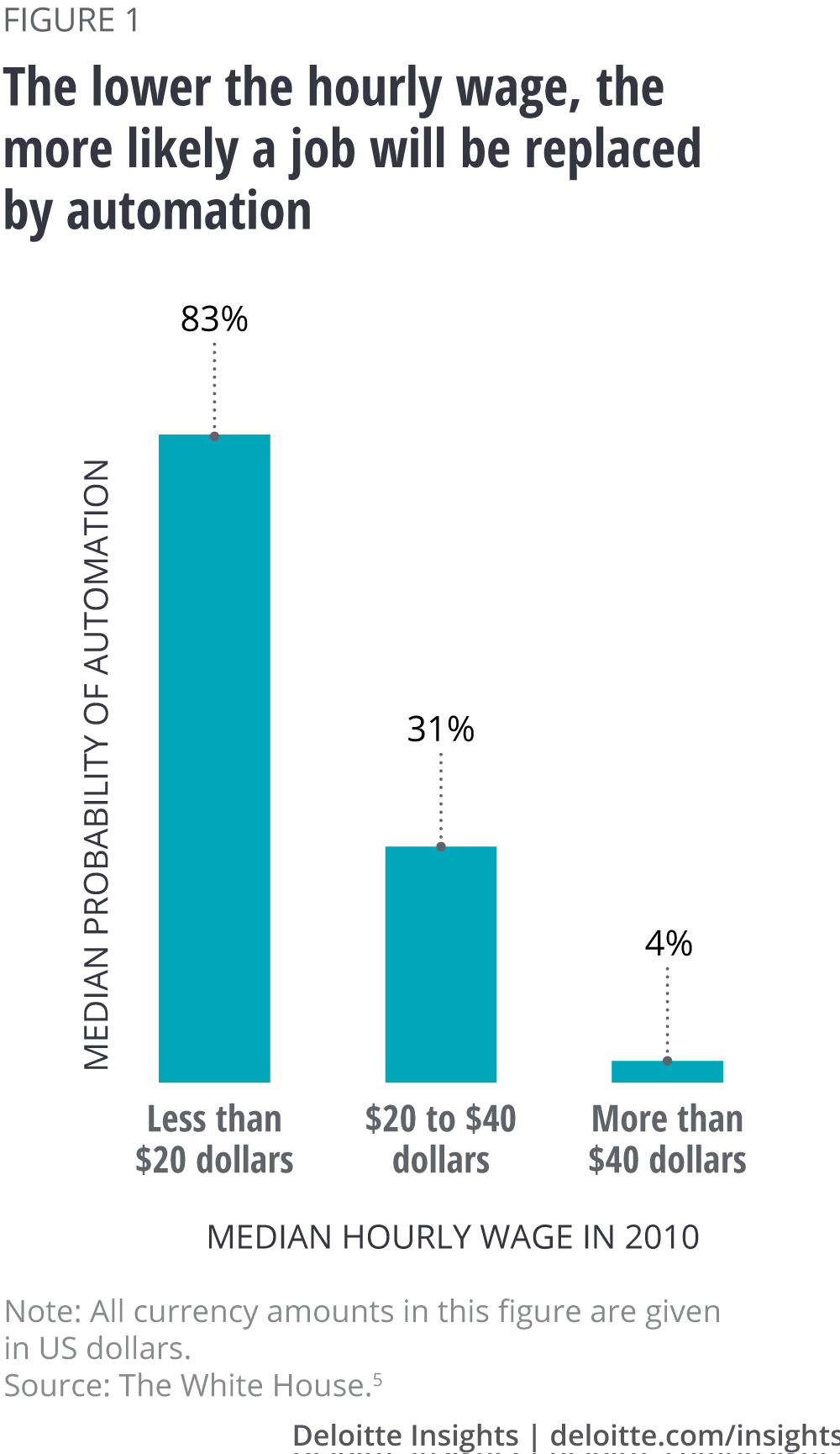
While the current US total unemployment rate is low at 4.1 percent, the decline in workforce participation—from 67.3 percent in early 2000 to 62.9 percent in March 2018—suggests that the number of discouraged workers has risen.6 In addition, the available low-skilled work rarely offers the pay and benefits displaced individuals historically enjoyed, such as the US$30-per-hour steel worker who loses his job and later finds work at a restaurant or delivering packages.
Many job training programs have struggled to demonstrate a positive impact for job seekers. In 2011, the Government Accountability Office (GAO) looked at federal employment and job training programs. The GAO found that “in fiscal year 2009, nine federal agencies spent approximately $18 billion to administer 47 programs,” while also noting that “little is known about the effectiveness of most programs … Nearly all programs track multiple outcome measures, but only five programs have had an impact study completed since 2004 to assess whether outcomes resulted from the program and not some other cause.”7 So, for those five programs that actually did conduct an impact study, what were the results? According to the GAO: “The five impact studies generally found that the effects of participation were not consistent across programs, with only some demonstrating positive impacts that tended to be small, inconclusive, or restricted to short-term impacts.”8
Part of the impetus for the WIOA Act of 2014 may have been the challenge in determining the impact of federal job training programs. WIOA requires states to report on the posttraining wages and employment status of participants, as well as to gather data about the education level characteristics. WIOA was also intended to provide workers with useful information about the training options that were available. As then-President Barack Obama noted at the signing of the WIOA legislation, “That means workers, as they’re shopping around for what’s available, they’ll know in advance if they can expect a good return on their investment.”9
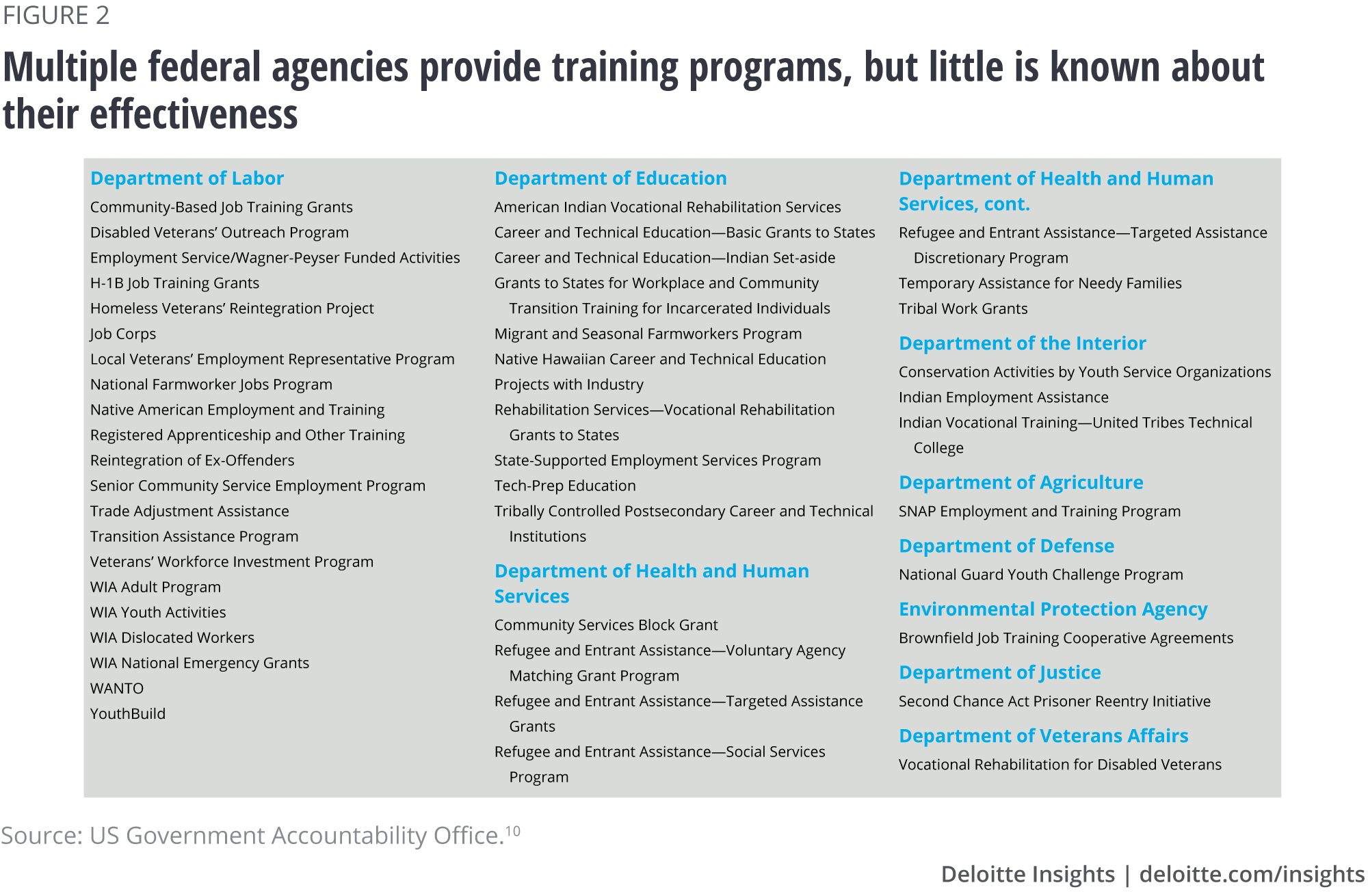
Efficacy information: Helping job seekers make better training choices
Participants in state-run WIOA training programs receive vouchers to select from an eligible training providers list of approved offerings.11 But how informed are participants when they are making choices about which training programs work best, especially for participants with similar abilities?
In evaluating the eligible provider lists, wide disparities exist in the information various states provide to job seekers to help them choose between training programs. Indeed, as of late 2017 only 30 states were offering online data on WIOA training providers, and, in many cases, the information provided was minimal.12 Most states have an opportunity to improve the way they help their citizens find the training and providers most likely to meet their needs.13
Figure 3 shows different levels of guidance that states might provide to those selecting training. The X-axis shows increasing job relevance of the training to employers (outcome), while the Y-axis shows increasing levels of information about the suitability of training to a particular individual (fit). In the same way that information is available about colleges both in terms of who attends (average SAT scores, majors, etc.) and in terms of job-readiness of graduates (employment rates and earnings of recent graduates), more information like this could help those seeking training make more informed choices.
Today, many states provide only basic program information—the names of programs and providers—and a few additional elements of information such as program duration and type. A few states such as Michigan, however, offer much more detail, such as performance, the target occupation of the program, and occupation demand. Not surprisingly, these programs in Michigan have an above-average impact for participants.14
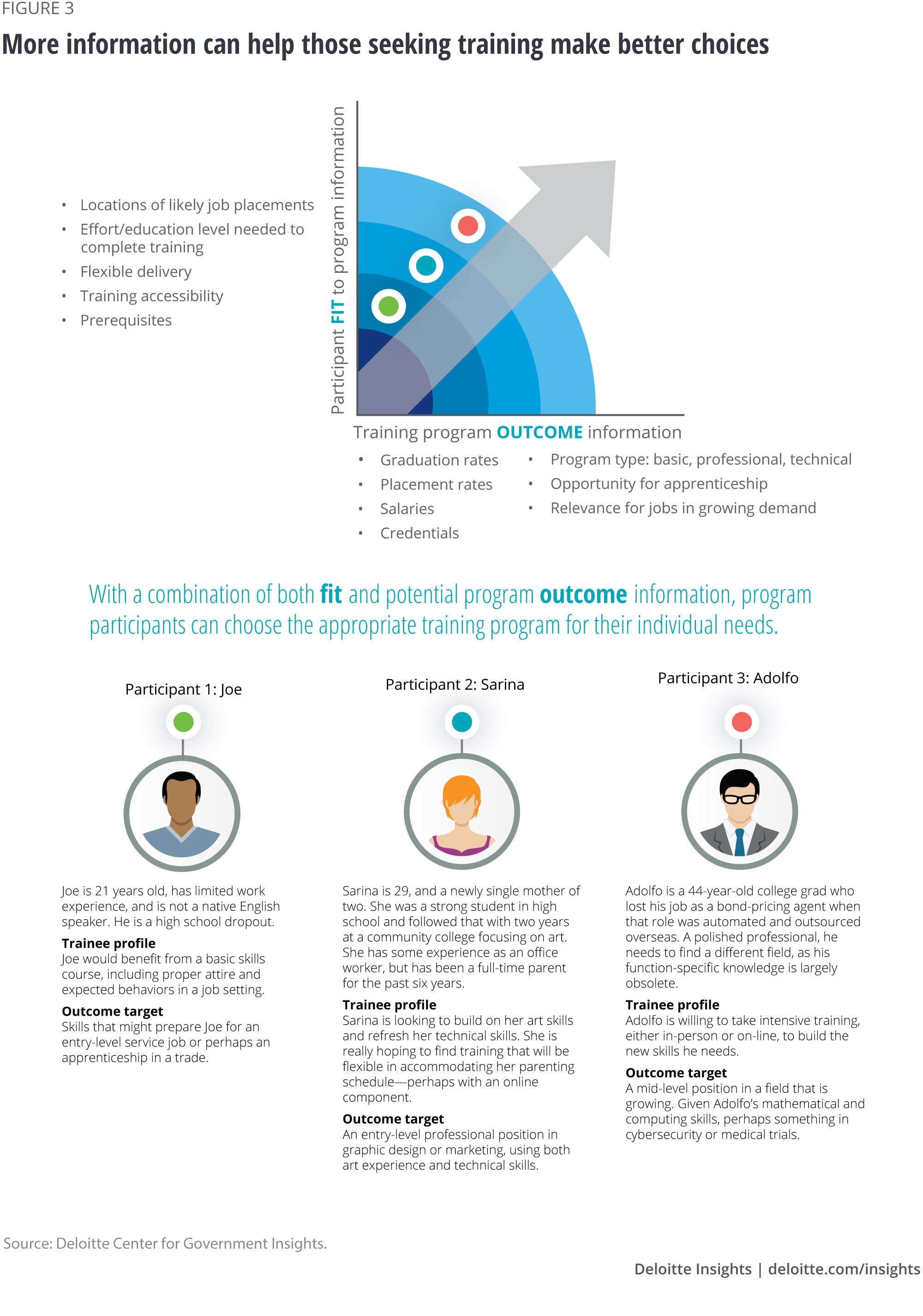
Summary of training improvement strategy 1: Provide efficacy information
- Provide WIOA participants with better information about training options, including success rates and demand information about target occupations.
- Update this information at regular intervals to reflect changes in occupational demand and training program performance.
- Use performance data to keep only high-performing programs in the eligible training provider list.
Tailored training: Target programs by segmenting participants
A diverse group of individuals participates in government workforce programs to upskill themselves and find jobs. Workforce development service providers can use a data-driven approach to segment participants to improve the outcomes of these programs.
The Workforce Innovation and Opportunity Act of 2014 required state governments to capture and share data on workforce programs to provide greater transparency into their performance. States are required to capture and report information on both participants (including education level, age, gender, and state of residence) and outcomes (in terms of employment status and wages).15 This data can help governments understand the impact of various types of training on various participants. The Deloitte Center for Government Insights analyzed WIOA data from 2013 and 2015 (See the related article “Workforce reinvention: The data analysis methodology” for details).
By segmenting participants based on education, our analysis indicates that the impact of training can vary greatly depending on participants’ educational profiles. For instance, among individuals with high school diplomas, those who received WIOA services earned between US$7,900 and US$13,000 more annually compared to nonparticipant peers. By contrast, WIOA participants with some college earned less than nonparticipants (table 1). This doesn’t necessarily mean that WIOA training diminished these individuals’ earning capability; rather, it suggests that those at higher education levels who avail these services could be challenged compared to the comparison group. In the absence of a control group, it’s impossible to say what impact, positive or negative, WIOA services may have had. Because of the large differences based on education level, however, it is likely that customer segmentation could help workforce boards identify which participant groups aren’t getting hoped-for benefits, and to redesign programs to target that group.
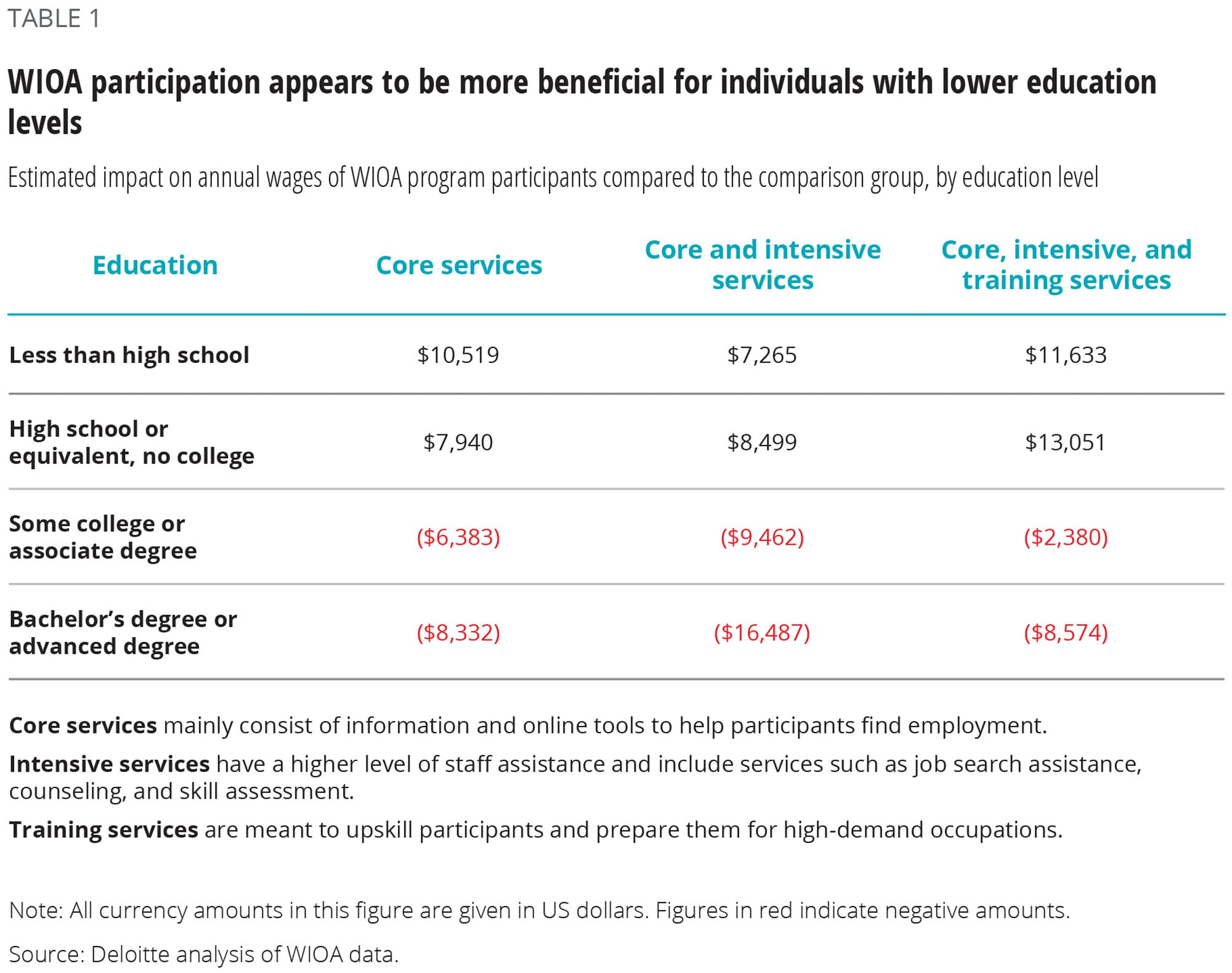
Summary of training improvement strategy 2: Tailored training
- Assess training for various participant segments. Use WIOA data to identify participant groups that are not benefitting from these programs, and consider tailoring programs for these groups.
- For instance, our analysis shows that WIOA programs have shown less value for more highly educated participants, so programs may need to be redesigned keeping this in mind.
Revisit training of older workers
The US population is aging. US Bureau of Labor Statistics (BLS) estimates that about 103 million people will be aged 55 years or older by 2025—more than 30 percent of the population.16 The oldest cohort is also projected to increase its labor force participation rate, just as it did over the prior 20-year period.17 Many older workers will likely rely on workforce development programs to find jobs or retrain themselves.
Figures 4 and 5 show WIOA workforce program participation for older workers between 2013 and 2015, and the impact of programs on their employment and wages.18 Relatively few participants—just 16 percent—were aged 55 or above. Similarly, the impact of these programs, in terms of employment and wages, was much lower for older participants. (Again, in the absence of a control group, the impact can be measured only against a comparison group, which consists of earnings data for nonparticipants of similar gender, education, and state captured by the federal Quarterly Workforce Indicators.) While conceivable that their outcomes could have been even worse in the absence of training, the data nonetheless suggests that either the content or delivery of workforce programs could be improved for older workers.
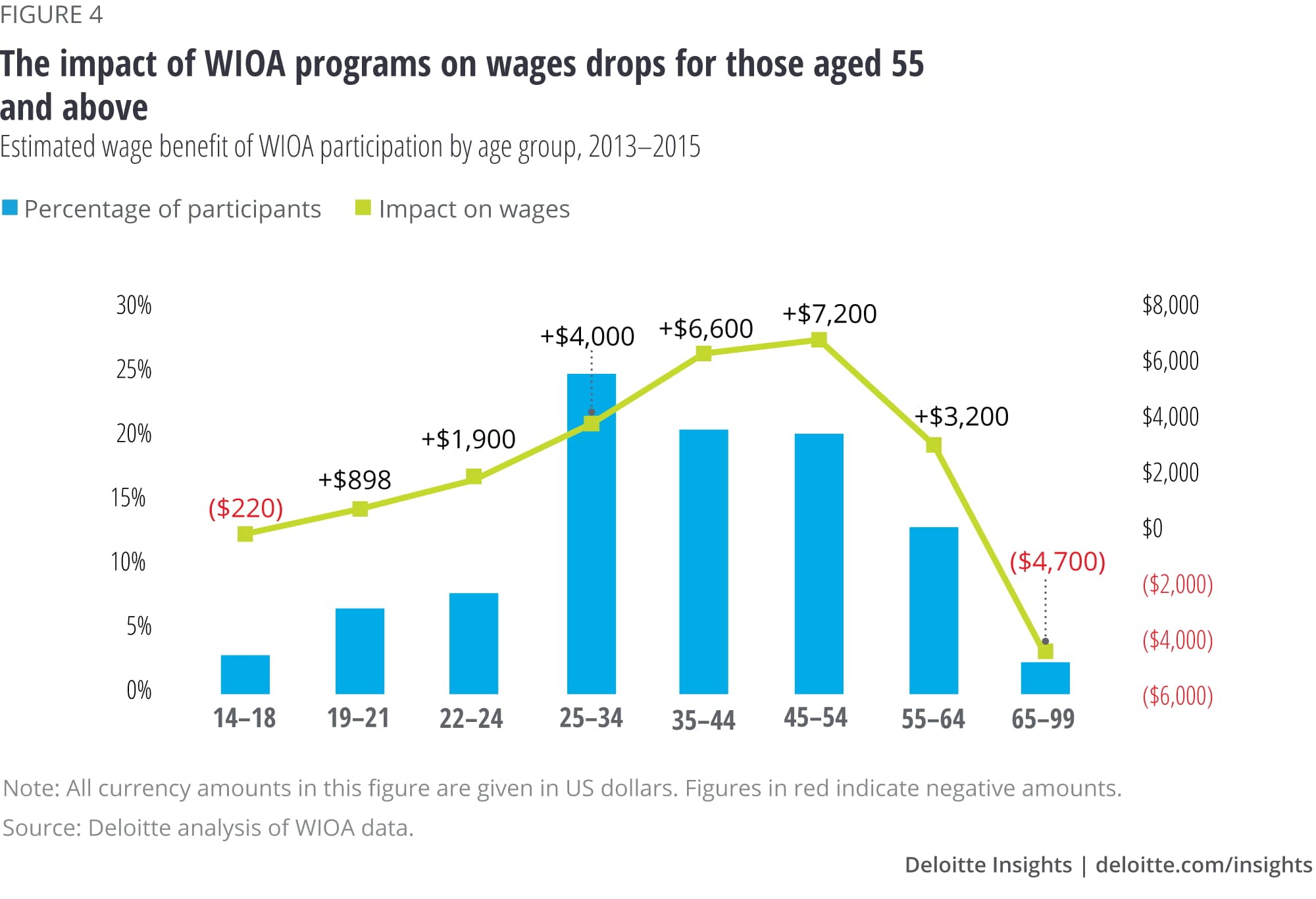
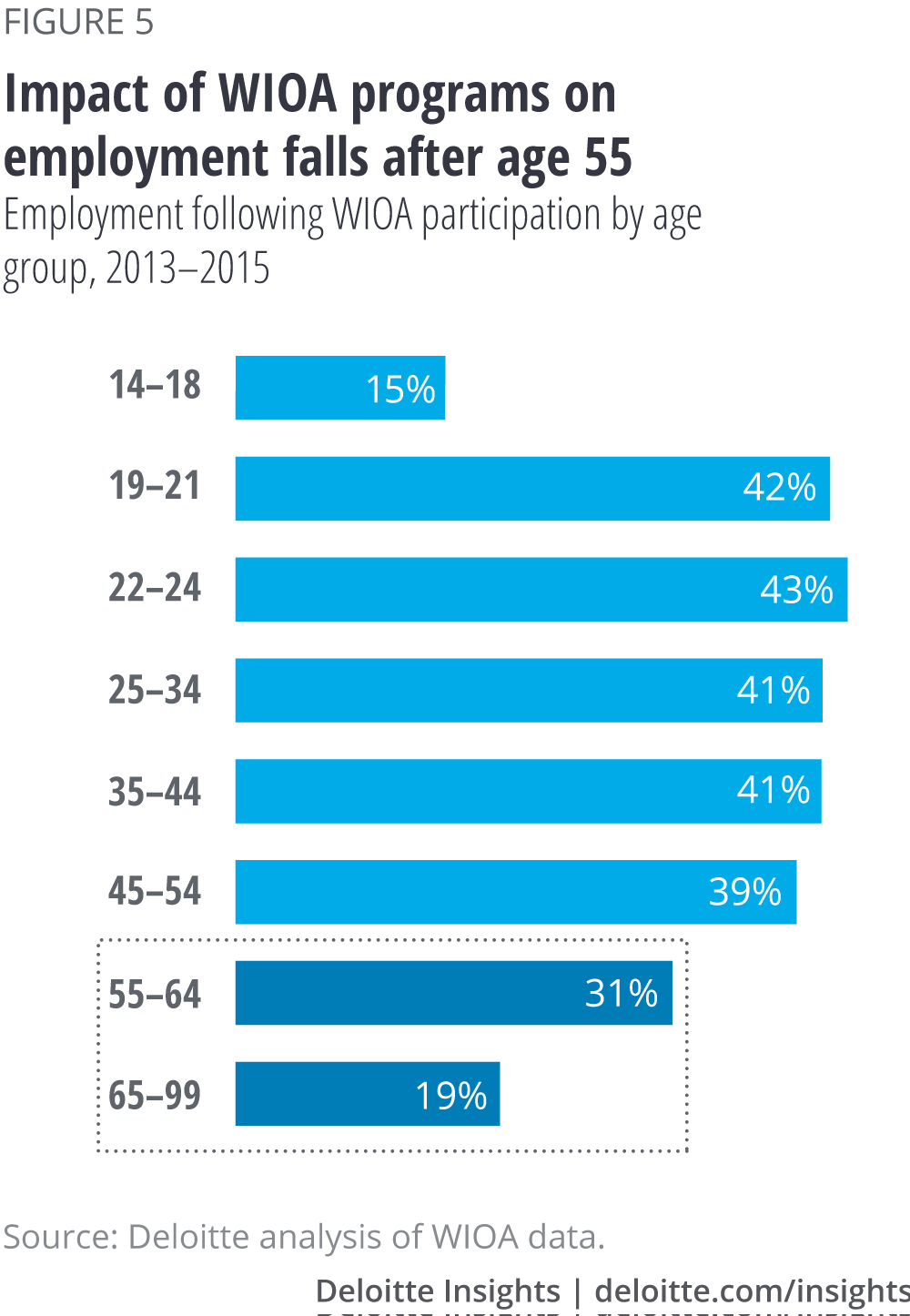
Summary of training improvement strategy 3: Revise the approach for mid-career/older workers
- The low participation rate of older workers may reflect a lack of awareness or a belief that these programs are not intended for them. States could do a better job of building awareness around these programs with this older population, which is growing in size.
- Certain jobs may be better suited for older workers. For example, a survey of Senior Community Service Employment Program (SCSEP) applicants found that a large proportion of older workers preferred part-time work.19 Workforce boards could collaborate with employers to identify such jobs, and then deliver training programs targeted to the needed skills for older workers.
Identify areas for opportunity: Comparing data to scale successful programs
The WIOA data allows policy leaders to compare different types of WIOA services, and to scale what works and modify or eliminate what doesn’t. In addition, states can compare their outcomes with other states to help gauge their performance relative to their peers. Through an evidence-based approach, it may be possible to identify successful approaches for scaling as well as opportunities for improvement.
Ten different types of training programs are provided under WIOA. The data shows that some programs have a higher impact on employment and wages. In one mid-western state, for instance, “customized training” and “skill upgrading” programs had a positive impact of US$7,633 and US$5,977, respectively, on participant wages. Only 199 participants received these types of trainings, however. Conversely, 11,012 participants in this state received occupational skills training, but estimate wages were lower after training (table 2).20 More research is needed to determine whether this disparity is due to program content or some form of selection bias. Given the data, however, states should consider using WIOA data to identify outliers, both positive and negative, in order to figure out why they yield anomalous outcomes.
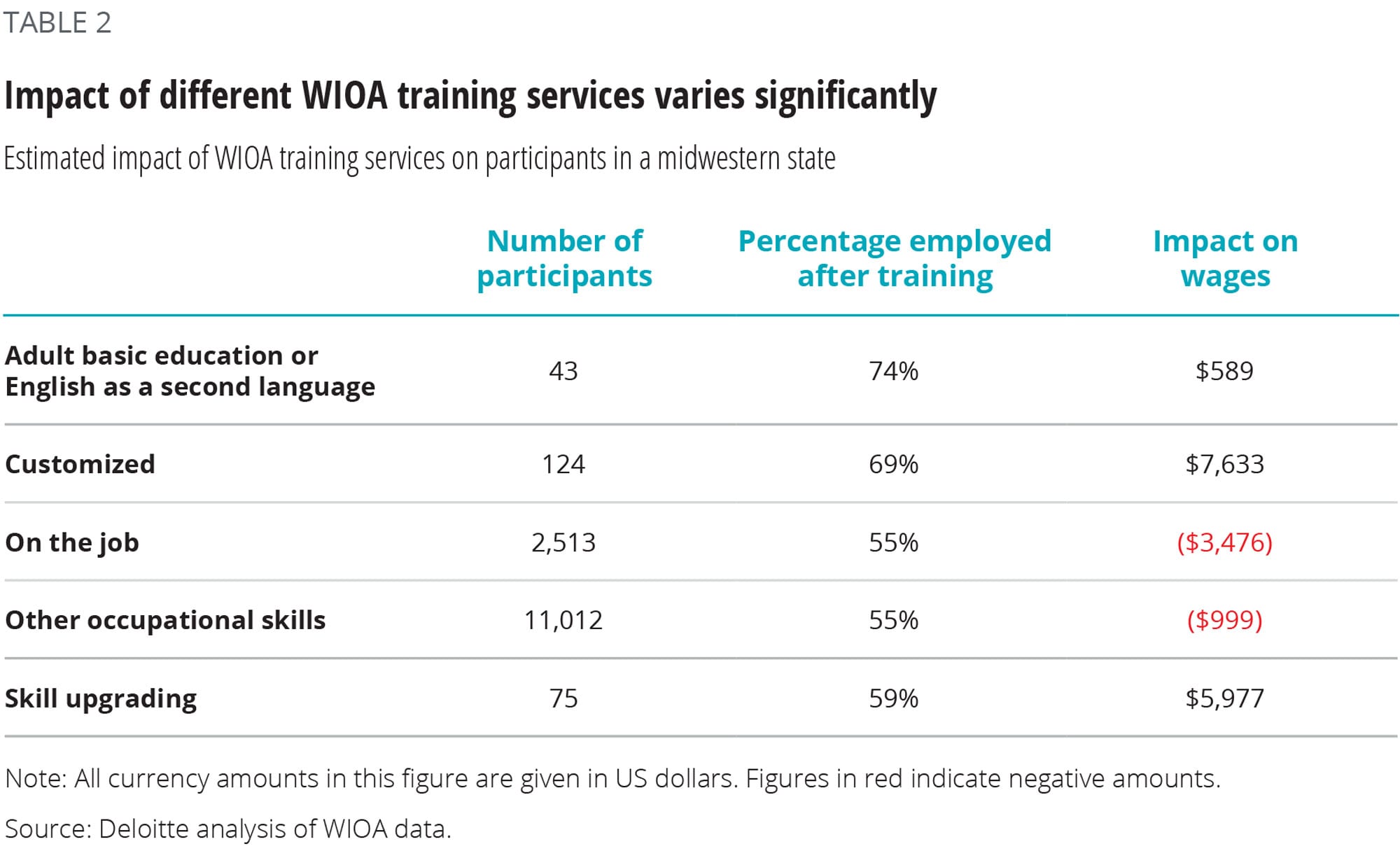
Summary of training improvement strategy 4: Identify opportunities for improvement
- Use the WIOA data to compare the performance of different types of training programs to identify and scale successful training approaches. Compare performance with other states to identify best practices and opportunities to drive improvement.
- Outliers, both positive and negative, can provide insight into what works and what doesn’t.
A new perspective on workforce reinvention
A whole new world of work is taking shape around us. Organizations and their workers can adapt to this new reality—or ignore it and risk being left behind. If we prepare ourselves well, the future of work offers tremendous opportunities.
Governments at all levels can help workers, businesses, and their own workforces prepare for the new reality. For workers and job seekers, state and local governments already have an infrastructure in place. These services can be improved through a data-driven approach that takes advantage of more and better WIOA data, allowing agencies to tailor training programs to better meet the needs of both job seekers and employers. With greater access to relevant information, workers should be able to select programs that prepare them for high-demand occupations.
Table of contents
- Why job training and reskilling are critical
- Efficacy information: Helping job seekers make better training choices
- Tailored training: Target programs by segmenting participants
- Revisit training of older workers
- Identify areas for opportunity: Comparing data to scale successful...
- A new perspective on workforce reinvention
